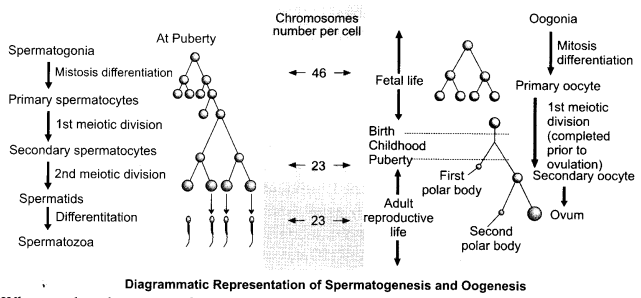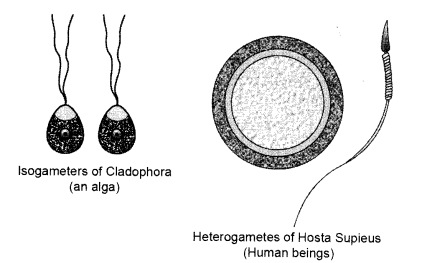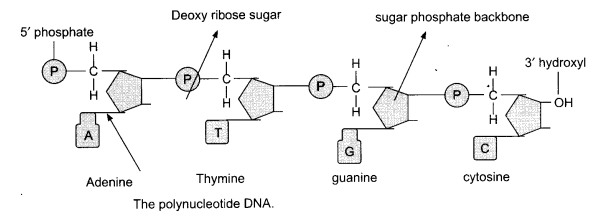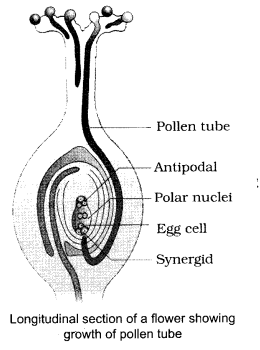These Sample papers are part of CBSE Sample Papers for Class 12 Biology. Here we have given CBSE Sample Papers for Class 12 Biology Paper 6.
CBSE Sample Papers for Class 12 Biology Paper 6
| Board | CBSE |
| Class | XII |
| Subject | Biology |
| Sample Paper Set | Paper 6 |
| Category | CBSE Sample Papers |
Students who are going to appear for CBSE Class 12 Examinations are advised to practice the CBSE sample papers given here which is designed as per the latest Syllabus and marking scheme as prescribed by the CBSE is given here. Paper 6 of Solved CBSE Sample Paper for Class 12 Biology is given below with free PDF download solutions.
Time Allowed: 3 hours
Maximum Marks: 80
General Instructions:
- There are total 26 questions and five sections in the question paper. All questions are compulsory.
- Section A contains question number 1 to 5, Very Short Answer Type Questions of one mark each.
- Section B contains question number 6 to 10, Short Answer Type Questions of two marks each.
- Section C contains question number 11 to 22, Short Answer Type Questions of three marks each.
- Section D contains question number 23, Value Based Question of four mark.
- Section E contains question number 24 to 26, Long Answer Type Questions of five marks each.
- There is no overall choice in the question paper, however, an internal choice is provided in one question of two marks, one question of three marks and all three questions of five marks. An examiner is to attempt any one of the question out of the two given in the question paper with the same question number.
- No. of printed pages are three.
SECTION-A
Question 1.
What is coleorhiza?
Question 2.
What is the advantage of use of biotechnology in molecular biology over traditional pathological tests?
Question 3.
What are cleistogamous flowers?
Question 4.
How is Agrobacterium tumefaciens considered useful?
Question 5.
Which attribute of human population do the following figures represent?

SECTION-B
Question 6.
What are the basic steps involved in genetically modifying an organism?
Question 7.
Explain the four types of barriers of Innate immunity.
Question 8.
What do you mean by inbreeding depression? How this problem should be solved during animal breeding?
OR
Write with examples, how use of microbes helps us to make different types of cheese with specific texture & flavors?
Question 9.
S strain → Inject into mice→ ……
….. → Inject into mice → Mice live
Complete the diagram above. What was this experiment about and who performed it?
Question 10.
What may be the reasons for low productivity of ocean?
SECTION-C
Question 11.
Discuss the barrier methods for contraception.
Question 12.
An individual has genotype with an extra chromosome 21.
(a) What is this disorder called?
(b) What will be the physical appearance?
Question 13.
Discuss the role of microbes in sewage treatment
Question 14.
What is DNA finger printing? On what principle does it work? Mention its two applications.
OR
Explain Miller’s experiment to prove the ‘theory of chemical origin of life’ as proposed by Oparin and Haldane.
Question 15.
Differentiate between spermatogenesis and oogenesis with a diagram.
Question 16.
What are the advantages of GM plants?
Question 17.
What do you understand by the term bio-pesticide? Name and explain the mode of action of a popular bio-pesticide
Question 18.
Represent schematically the life cycle of malarial parasite.
Question 19.
Compare and contrast: isogamy and anisogamy. With examples.
Question 20.
Answer the following:
(a) Expand IUT.
(b) In which part of the female reproductive system the 8-celled embryo will be transferred during test tube baby programme.
Question 21.
Halpoid content of human DNA is 3.3 x 109 bp and the distance between 2 consecutive bp is 0.34x 10-9. What is the length of the DNA molecule?
Question 22.
Explain convergent evolution with examples.
SECTION-D
Question 23.
Rakhi and her parents were watching a TV serial in the evening. During a commercial break, an advertisement flashed on the screen which was promoting use of sanitary napkins. Rakhi was still watching the TV. The parents got embarrassed and changed the channel. Rakhi objected to her parent’s behaviour and explained the need for these advertisements.
(a) What values did the parents show?
(b) Briefly describe the phases of a menstrual cycle.
SECTION-E
Question 24.
Plant breeding programmes are carried out in a systematic way worldwide. Explain the five main steps in breeding a new genetic variety.
OR
Why are CO2, CH4, N2Oetc known as greenhouse gases?
Why is CNG better than Diesel?
Question 25.
What are chromosomal disorders?
OR
(a) Explain primary productivity and the factors that influence it. 5
(b) Describe how oxygen and chemical composition of detritus control decomposition.
Question 26.
Draw schematically a single polynucleotide strand (with at least three nucleotides). Provide labels and directions.
OR
What are the post pollination events? Explain it.
Answers
SECTION-A
Answer 1.
In embryos of monocots the root cap and radicle are enclosed in an undifferentiated sheath called coleorhiza.
Answer 2.
Biotechnological methods make early diagnosis possible to detect a disease and start treatment at an early stage rather conventional methods of diagnosis where it is not possible.
Answer 3.
Self pollinating flowers in which stamens and pistil are in close proximity.
Answer 4.
Agrobacterium tumefaciens help a tumor causing gene in the bacteria to be substituted with a gene of interest and its introduction into plants.
Answer 5.
The figures represent the age pyramids of human population as Expanding Stable and Declining
SECTION-B
Answer 6.
Three basic steps involved in genetically modifying an organism are:
- Identification of DNA with desirable genes.
- Introduction of the identified DNA into the host.
- Maintenance of introduced DNA in the host and transfer of the DNA to its progeny.
Answer 7.
Innate immunity consists of four types of barriers. These are:
- Physical barriers: Skin on our body is the main barrier which prevents entry of the microorganisms.
- Physiological barriers: Acid in the stomach, saliva in the mouth, tears from eyes-all prevent microbial growth.
- Cellular barriers: Certain types of leukocytes (WBC) of our body like polymorpho-nuclear leukocytes (PMNL-neutrophils) and monocyte can phagocytose and destroy microbes.
- Cytokine barriers: Virus-infected cells secrete proteins called interferons which protect non-infected cells from further viral infection.
Answer 8.
Continued inbreeding, especially close inbreeding, usually reduces fertility and even productivity. This is called inbreeding depression. This problem can be solved by selecting animals of the breeding population to be mated with unrelated superior animals of the same breed which usually helps restore fertility and yield.
OR
The specificity of texture, flavour and taste in different variety of cheese comes from microbes used. For example,
- The large holes in ‘Swiss Cheese’ are due to production of a large amount of CO, by Propionibacterium sharmanii.
- The ‘Roquefort cheese’ are ripended by growing a specific fungi on them, which gives them a particular flavor
Answer 9.
S strain → Inject into mice → Mice die
R strain → Inject into mice →Mice live
Answer 10.
Low productivity of ocean is due to:
- Lack of light.
- High salinity.
- High pressure and
- Waves and tides
Answer 11.
Various barrier methods available for both males and females are:
(1) Condoms: Barriers made of thin rubber/latex sheath that are used to cover the penis in the male or vagina and cervix in the female, just before coitus so that the ejaculated semen would not enter into the female reproductive tract.
(2) Diaphragms, Cervical Caps and Vaults: Barriers made of rubber that are inserted into the female reproductive tract to cover the cervix during coitus. They prevent conception by blocking the entry of sperms through the cervix. They are reusable. Spermicidal creams, jellies and foams are usually used along with these barriers to increase their contraceptive efficiency.
(3) Intra Uterine Devices (IUDs): These devices are inserted by doctor or expert nurses in the uterus through vagina. These are presently available as the non-medicated IUDs (g., Lippes loop), copper releasing IUDs (CuT, Cu7, Multiload 375) and the hormone releasing IUDs (Progestasert, LNG-20). IUDs increase phagocytosis of sperms within the uterus and the Cu ions released suppress sperm motility and the fertilising capacity of sperms. The hormone releasing IUDs, in addition, make the uterus unsuitable for implantation and the cervix hostile to the sperms.
Answer 12.
An individual has genotype with an extra chromosome 21.
(a) The disorder is called Down’s syndrome or trisomy of 21.
(b) The affected individual is short statured with small round head, furrowed tongue and partially open mouth. Palm is broad with characteristic palm crease. Physical, psychomotor and mental development is retarded.
Answer 13.
Heterotrophic microbes naturally present in the sewage plays a major role in the treatment of sewage which is carried out in two stages:
Primary Treatment: This initially involves removal of floating debris by sequential filtration followed by grit (soil and small pebbles) removal by sedimentation. All solids that settle down form the primary sludge, and the supernatant forms the effluent. The effluent from the primary settling tank is taken for secondary treatment.
Secondary Treatment or Biological Treatment: The primary effluent is passed into large aeration tanks where it is constantly agitated mechanically and air is pumped into it. This allows vigorous growth of useful aerobic microbes into floes. The significantly reduced BOD (biochemical oxygen demand) of the effluent is then passed into a setting tank where the bacterial ‘floes’ are allowed to form activiated sludge. A small part of the activated sludge is pumped back into the aeration tank to serve as the inoculum. The remaining major part of the sludge is pumped into anaerobic sludge digesters, where, other kinds of bacteria digest the bacteria and the fungi in the sludge. During this digestion, bacteria produce a mixture of gases such as methane, hydrogen sulphide and carbon dioxide. These gases form biogas and can be used as source of energy as it is inflammable.
Answer 14.
DNA finger printing is a genetic molecular method that identifies and evaluates an individual from another individual on the basis of unique patterns (polymorphisms) in their DNA. DNA finger printing works on a principle of repetitive DNA sequences that gives a unique identity to an individual. These repetitive DNA are separated from bulk genomic DNA as different peaks during density gradient centrifugation and categories, into micro-satellites, mini-satellites. These sequence normally do not code for any proteins, but they form a large portion of human genome. These sequence show high degree of polymorphism and form the basis of DNA finger printing. Its two applications are:
- As an identification tool in forensics.
- Paternity testing, in case of disputes.
OR
Oparin and Haldane proposed that the first form of life could have come from pre-existing non-living organic molecules (e.g. RNA, protein, etc.) and that formation of life was preceded by chemical evolution, i.e. formation of diverse organic molecules from inorganic constitutents. The conditions on earth were—high temperature, volcanic storms, reducing atmosphere containing CH4, NHr Miller created similar conditions in a laboratory scale. He created electric discharge in a closed flask containing CH4, H2, NH3 and water vapour at 8000° C. He observed formation of amino acids. In similar experiments others observed, formation of sugars, nitrogen bases, pigment and fats. Analysis of meteorite content also revealed similar compounds indicating that similar processes are occurring else where in space.
Answer 15.

Answer 16.
Genetically Modified crops/plants have the following advantages:
- Crops are more tolerant to abiotic stresses (cold, drought, salt, heat).
- Have reduced reliance on chemical pesticides (pest-resistant crops).
- Helpful in reduction of post harvest losses.
- Plants have increased efficiency of mineral usage to prevent early exhaustion of fertility of soil.
- Crops yield enhanced nutritional value of food, e.g., Vitamin ‘A’ enriched rice.
- Tailor-made plants have created alternative resources for industries, in the form of starches, fuels and pharmaceuticals.
Answer 17.
Bio-pesticides are derived from natural materials such as animals, plants, bacteria and certain minerals. This microbial bio-control agents that is used to control butterfly caterpillars is the bacteria Bacillus thuringiensis (often written as Bt). These are mixed with water and sprayed onto vulnerable plants such as brasssicas and fruit trees, where these are eaten by the insect larvae. In the gut of the larvae, the toxin is released and the larvae get killed. The bacterial disease will kill the caterpillars, but leave other insects unharmed.method of controlling pests relies on natural predation rather than introduced chemicals. An example of B. thuringiensis toxin genes has also been introduced with the help of genetic engineering into plants which offers resistance to insect pests. Bt-cotton is one such example
Answer 18.

Answer 19.
| Isogamy | Anisogamy |
| 1. fusing gametes do not differ morphologically. | 1. Fusing gametes differ in size or motility. |
| 2. Male & female gamete cannot be categories. | 2. Male gamete is called antherozoid or sperm and female gamete is called egg or ovum. |
| 3. Take place in unicellular organisms, e.g., Alga | 3. Take place in some fungi and higher vertebrates, i.e., human beings. |

Answer 20.
(a) IUT stands for Intra Uterine transfer. The 8-celled embryo developed by In-vitro fertilization or ICSI is transferred in this technique.
(b) The 8-celled embryo is transferred to the uterus.
Answer 21.
Haploid content is 3.3 x 109
Therefore, diploid content is 6.6 x 109 Distance between bp is 0.34 x 10-9
Therefore length is diploid content x distance between bp = 6.6 x 109 x 0.34 x 10 9 = 2.24 m
Answer 22.
Convergent evolution occurs when more than one adaptive radiation appear to have occurred in an isolated geographical area of different habitats. The analogous organs have almost similar appearance and perform the same function but develop in different groups and are totally different in their basic structure and development origin. For example, Darwins’ Finches and Australian Marsupials where each marsupial differ from each other.
SECTION-D
Answer 23.
(a) The parents were traditional but understood the need for such advertisements. They showed maturity and openness later.
(b)
- Menstrual phase
- Proliferative phase
- Ovulatory phase
- Secretory phase.
| Phases of Menstrual Cycle | ||
| Phases | Days | Events |
| Menstrual phase | 1st-5th | Menstruation begins when the endometrium breaks down. The cells of endometrium, secretions, blood and the unfertilised ovum constitute the mentmal flow. Progesterone production is reduced. |
| Proliferative phase | 6th-13th | Endometrium rebuilds, FSEI creation and estrogen’s secretion increase. |
| Ovulatory phase | 14th | Both LH and FSH attain a peak level. Concentration of estrogen in the blood is also high and reaches its peak. Ovulation occurs. |
| Secretory phase | 15th-28th | Corpus luteum secretes progesterone. Endometrium thickens and uterine glands become secretory. |
Answer 24.
The main steps in breeding a new genetic variety of a crop are as follows:
(1) Collection of Variability: The entire collection of plants/seeds having all the diverse alleles for all genes including all the different wild varieties, species and relative of the cultivated species in a given crop called as germplasm collection, is collected.
(2) Evaluation and Selection of Parents: The germplasm is evaluated so as to identity plants with desirable combination of characters. The selected plants are multiplied and used in the process of hybridization.
(3) Cross Hybridization among the Selected Parents: The desired characters are combined from two different plants (parents), to produce hybrids that genetically combine the desired characters in one plant. This is a very time-consuming and tedious process since the pollen grains from the desirable plant chosen as male parent have to be collected and placed on the stigma of the flowers selected as female parent. Usually only one in few hundred to a thousand crosses shows the desirable combination, for example high protein quality of one parent may need to be combined with disease resistance from another parent.
(4) Selection and Testing of Superior Recombinants: Progency plants that are superior to both of the parents are selected. The selection process is crucial to the success of breeding objective and requires careful scientific evaluation of the progency.
(5) Testing, Release and Commercialization of new Cultivars: The newly selected lines are evaluated for their yield and other agronomic traits of quality, disease resistance etc. The material is then evaluated in comparison to the best available local crop cultivar usually by a check or reference cultivar.
Answer 25.
| Chromosomal Disorders | Causes | Affects |
| 1. Down’s Syndrome | By the presence of an additional copy of chromosome number 21, Trisomy. | Individual is short statured with small round head, furrowed tongue and partially open mouth. Palm is broad with palm crease. Physical, psychomotor and mental development is retarded. |
| 2. Klinefelter’s Syndrome | By the presence of an additional copy of X chromosome resulting into Karyotpye of 47, XXY. | Masculine and feminine development and sterilisation. |
| 3. Turner’s Syndrome | Due to the absence of one of the X chromosome 45 with X20. | Such females are sterile as ovaries are rudimentary and lack other secondary sexual characters. |
OR
(a) Primary productivity is defined as the amount of biomass or organic matter produced per unit area
over a time period by plants during photosynthesis. It is expressed in terms of weight (g 2) or energy
(kcal nr2). It is also expressed in terms of g 2 yr1 or (kcal nr2) yr1 to compare the productivity of different ecosystems.
It is divided into gross primary productivity (GPP), net primary productivity (NPP) and secondary productivity.
Gross primary productivity of an ecosystem is the rate of production of organic matter ditfing photosynthesis.
Net primary productivity is the available biomass for the consumption to heterotrophs (herbivores and decomposers), i.e., NPP = GPP – R.
Secondary productivity is defined as the rate of-formation of new organic matter by consumers.
The factors on which primary productivity depends are: (z) Plant species inhabiting a particular area, (ii) On a variety of environmental factors such as availability of nutrients. (iii) Photosynthetic capacity of plants.
(b) Decomposition is an oxygen-requiring process. The rate of decomposition is controlled by both chemical composition of detritus and climatic factors. In a particular climatic condition, decomposition rate is slower if detritus is rich in lignin and chitin, and quicker, if detritus is rich in nitrogen and water-soluble substances like sugars. Temperature and soil moisture are the most important climatic factors that regulate decomposition through their effects on the activities of soil microbes. Warm and moist environment favour decomposition whereas low temperature and anaerobiosis inhibit decomposition resulting in build up of organic matter.
Answer 26.

The post pollination events are:
1. The pollen grain germinates on the stigma to produce a pollen tube through one of the germ pores.
2. The contents of the pollen grain move into the pollen tube. Pollen tube grows through the tissues of the stigma and style and reaches the ovary.
3. The generative cell divides and forms the two male gametes during the growth of pollen tube in the stigma.
4. Pollen tube, after reaching the ovary, enters the ovule through the micropyle and then enters one of the synergids through the filiform apparatus.
All these events are together referred to as pollen-pistil interaction also.

We hope the CBSE Sample Papers for Class 12 Biology Paper 6 help you. If you have any query regarding CBSE Sample Papers for Class 12 Biology Paper 6, drop a comment below and we will get back to you at the earliest.